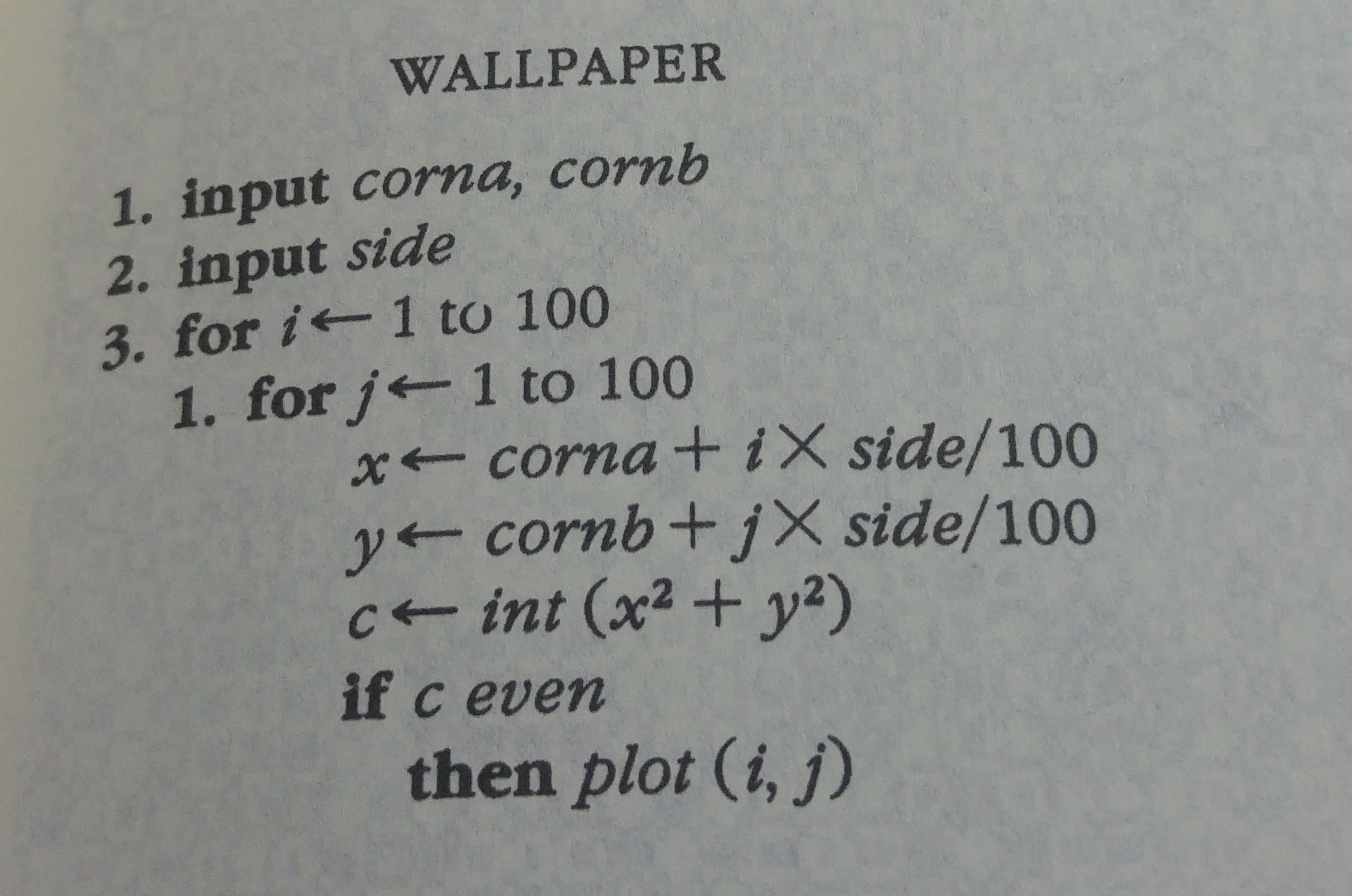I have started to read The New Turing Omnibus - a book that offers 66 concise, brilliantly written articles on the major points of interest in computer science theory, technology and applications.
From time to time, I will write a blog post presenting a chapter of this book.

Today, I am glad to present an interactive version of Chapter 1 about algorithms in general.
The algorithm
In order to explain what is an algorithm, the author presents a simple recipe for generating wallpapers.
Here is the recipe:

Now, we are going to code this algorithm in javascript and you will be able to play with it right in your browser thanks to the interactive Klipse snippets.
Preliminaries
First, we need a function that draws a color pixel on a canvas:
function drawPixel(canvas, x, y, color) {
let ctx = canvas.getContext("2d"),
scale = 2;
ctx.fillStyle = color;
ctx.fillRect(x * scale, y * scale, scale, scale)
}
Then, a function that erases a canvas i.e. color it in white:
function resetCanvas (canvas){
let ctx = canvas.getContext("2d");
ctx.fillStyle = "white";
ctx.fillRect(0, 0, canvas.width,canvas.height);
};
Black and White Wallpaper
The algorithm is controlled by the geometry of a square:
- its
x-position nameda - its
y-position namedb - the side of the square named
side
function drawBwWallpaper(canvas, a, b, side){
const points = 200;
for(let i=0; i< points; i++)
for(let j=0; j< points; j++) {
const x = a + i * side/points;
const y = b + j * side/points;
const c = Math.floor(x*x + y*y);
if (c % 2 === 0) {
drawPixel(canvas, i, j, "black");
}
}
}
drawBwWallpaper(canvas, 5, 5, 9);
The cool thing about this algorithm is that when we modify the side of the square, we get a completly different pattern:
drawBwWallpaper(canvas, 5, 5, 100)
Go ahead, play with the code…
The interactive code snippets are powered by the Klipse plugin.
Three Colors
We can generate a 3-color wallpaper by calculating the remainder of c modulo 4 and chose a color accordingly:
function choseColor(c) {
let colors = ["red", "green", "blue", "white"];
return colors[c % 4];
}
function drawColorWallpaper(canvas, a, b, side){
const points = 200;
for(let i=0; i<points; i++){
for(let j=0; j<points; j++) {
const x = a + i * side/points;
const y = b + j * side/points;
const c = Math.floor(x*x + y*y);
drawPixel(canvas, i, j, choseColor(c));
}
}
}
drawColorWallpaper(canvas, 5, 7, 100)
Again, when we modify the side of the square, we get a completly different pattern:
drawColorWallpaper(canvas, 5, 7, 57)
Grand Finale
Someone in reddit suggested to loop over the value of side in order to watch all the generated wallpapers like a movie.
Here is the result:
if(! window.interval) {
window.interval = null;
}
let side = 0;
const delta = 0.5;
function step(canvas, container) {
container.innerHTML = `side: ${side}`;
resetCanvas(canvas);
drawColorWallpaper(canvas, 5, 7, side);
side += delta;
}
clearInterval(window.interval);
window.interval = setInterval(step, 500, canvas, klipse_container);
Are you able to provide a simple explanation about this algorithm?
How is it able to generate so many different beautiful patterns?
Have you found a magnificient pattern? Please share its code…
